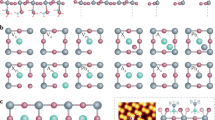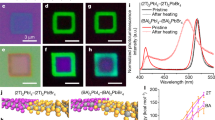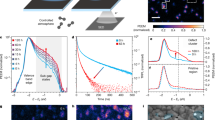Abstract
The ability to reduce energy loss at semiconductor surfaces through passivation or surface field engineering is an essential step in the manufacturing of efficient photovoltaic (PV) and optoelectronic devices. Similarly, surface modification of emerging halide perovskites with quasi-two-dimensional (2D) heterostructures is now ubiquitous to achieve PV power conversion efficiencies (PCEs) >25%, yet a fundamental understanding to how these treatments function is still generally lacking. Here we use a unique combination of depth-sensitive nanoscale characterization techniques to uncover a tunable passivation strategy and mechanism found in perovskite PV devices that were the first to reach the >25% PCE milestone. Namely, treatment with hexylammonium bromide leads to the simultaneous formation of an iodide-rich 2D layer along with a Br halide gradient that extends from defective surfaces and grain boundaries into the bulk three-dimensional (3D) layer. This interface can be optimized to extend the charge carrier lifetime to record values >30 μs and to reduce interfacial recombination velocities to values as low as <7 cm s−1.
This is a preview of subscription content, access via your institution
Access options
Access Nature and 54 other Nature Portfolio journals
Get Nature+, our best-value online-access subscription
$29.99 / 30 days
cancel any time
Subscribe to this journal
Receive 12 digital issues and online access to articles
$119.00 per year
only $9.92 per issue
Buy this article
- Purchase on Springer Link
- Instant access to full article PDF
Prices may be subject to local taxes which are calculated during checkout




Similar content being viewed by others
Data availability
All data generated or analysed during this study are included in the published article and its Supplementary Information and Source Data files. Source data are provided with this paper.
Code availability
The MATLAB and Python code used in this work are available from the corresponding authors upon reasonable request.
Change history
05 April 2024
A Correction to this paper has been published: https://doi.org/10.1038/s41560-024-01517-7
References
Haegel, N. M. et al. Photovoltaics at multi-terawatt scale: waiting is not an option. Science 380, 39–42 (2023).
Jean, J. & Brown, P. Emerging Photovoltaic Technologies (IOP Science, 2020).
Yablonovitch, E., Miller, O.D. & Kurtz, S. R. The opto-electronic physics that broke the efficiency limit in solar cells. In 2012 38th IEEE Photovoltaic Specialists Conference 001556–001559 (IEEE, 2012).
Poplawsky, J. D. et al. Structural and compositional dependence of the CdTexSe1-x alloy layer photoactivity in CdTe-based solar cells. Nat. Commun. 7, 12537 (2016).
Hwang, S.-T. et al. Bandgap grading and Al0.3Ga0.7As heterojunction emitter for highly efficient GaAs-based solar cells. Sol. Energy Mater. Sol. Cells 155, 264–272 (2016).
Nakamura, M. et al. Cd-free Cu(In,Ga)(Se,S)2 thin-film solar cell with record efficiency of 23.35%. IEEE J. Photovolt. 9, 1863–1867 (2019).
Feurer, T. et al. Single-graded CIGS with narrow bandgap for tandem solar cells. Sci. Technol. Adv. Mater. 19, 263–270 (2018).
Kim, J. Y. et al. Single-step fabrication of quantum funnels via centrifugal colloidal casting of nanoparticle films. Nat. Commun. 6, 7772 (2015).
Brown, G. F., Ager, J. W., Walukiewicz, W. & Wu, J. Finite element simulations of compositionally graded InGaN solar cells. Sol. Energy Mater. Sol. Cells 94, 478–483 (2010).
Takamoto, T., Ikeda, E., Kurita, H. & Ohmori, M. Over 30% efficient InGaP/GaAs tandem solar cells. Appl. Phys. Lett. 70, 381–383 (1997).
Bertness, K. A. et al. 29.5%‐efficient GaInP/GaAs tandem solar cells. Appl. Phys. Lett. 65, 989–991 (1994).
Lee, J. W., Tan, S., Seok, S. I., Yang, Y. & Park, N. G. Rethinking the A cation in halide perovskites. Science 375, eabj1186 (2022).
Yoo, J. J. et al. Efficient perovskite solar cells via improved carrier management. Nature 590, 587–593 (2021).
deQuilettes, D. W. et al. Impact of microstructure on local carrier lifetime in perovskite solar cells. Science 348, 683–686 (2015).
Ahrenkiel, R. K. in Semiconductors and Semimetals Vol. 39 (eds Ahrenkiel, R. K. & Lundstrom, M.S.) Ch. 2 (Elsevier, 1993).
Yoo, J. J. et al. An interface stabilized perovskite solar cell with high stabilized efficiency and low voltage loss. Energy Environ. Sci. 12, 2192–2199 (2019).
deQuilettes, D. W. et al. Charge-carrier recombination in halide perovskites. Chem. Rev. 119, 11007–11019 (2019).
Kirchartz, T., Márquez, J. A., Stolterfoht, M. & Unold, T. Photoluminescence‐based characterization of halide perovskites for photovoltaics. Adv. Energy Mater. 10, 1904134 (2020).
Cuevas, A. & Macdonald, D. Measuring and interpreting the lifetime of silicon wafers. Sol. Energy 76, 255–262 (2004).
Ohnesorge, B. et al. Minority-carrier lifetime and efficiency of Cu(In,Ga)Se2 solar cells. Appl. Phys. Lett. 73, 1224–1226 (1998).
McConnell, S. R. K. A. R. Requirements for a 20%-efficient polycrystalline GaAs solar cell. AIP Conf. Proc. 404, 191–205 (1997).
Aberle, A. G. Surface passivation of crystalline silicon solar cells: a review. Prog. Photovoltaics Res. Appl. 8, 473–487 (2000).
Gutierrez-Partida, E. et al. Large-grain double cation perovskites with 18 μs lifetime and high luminescence yield for efficient inverted perovskite solar cells. ACS Energy Lett. 6, 1045–1054 (2021).
deQuilettes, D. W. et al. Photoluminescence lifetimes exceeding 8 μs and quantum yields exceeding 30% in hybrid perovskite thin films by ligand passivation. ACS Energy Lett. 1, 438–444 (2016).
Jiang, Q. et al. Surface passivation of perovskite film for efficient solar cells. Nat. Photon. 13, 460–466 (2019).
He, T. et al. Reduced-dimensional perovskite photovoltaics with homogeneous energy landscape. Nat. Commun. 11, 1672 (2020).
Wei, M. et al. Combining efficiency and stability in mixed tin–lead perovskite solar cells by capping grains with an ultrathin 2D layer. Adv. Mater. 32, e1907058 (2020).
Alarousu, E. et al. Ultralong radiative states in hybrid perovskite crystals: compositions for submillimeter diffusion lengths. J. Phys. Chem. Lett. 8, 4386–4390 (2017).
Krückemeier, L., Krogmeier, B., Liu, Z., Rau, U. & Kirchartz, T. Understanding transient photoluminescence in halide perovskite layer stacks and solar cells. Adv. Energy Mater. 11, 2003489 (2021).
Crothers, T. W. et al. Photon reabsorption masks intrinsic bimolecular charge-carrier recombination in CH3NH3PbI3 perovskite. Nano Lett. 17, 5782–5789 (2017).
Frisk, C. et al. Optimizing Ga-profiles for highly efficient Cu(In,Ga)Se2 thin film solar cells in simple and complex defect models. J. Phys. D 47, 485104 (2014).
Yang, Y. et al. Top and bottom surfaces limit carrier lifetime in lead–iodide perovskite films. Nat. Energy 2, 16207 (2017).
Proppe, A. H. et al. Multication perovskite 2D/3D interfaces form via progressive dimensional reduction. Nat. Commun. 12, 3472 (2021).
Sutanto, A. A. et al. 2D/3D perovskite engineering eliminates interfacial recombination losses in hybrid perovskite solar cells. Chem 7, 1903–1916 (2021).
Fu, F. et al. Compositionally graded absorber for efficient and stable near-infrared-transparent perovskite solar cells. Adv. Sci. 5, 1700675 (2018).
Green, M. A. et al. Solar cell efficiency tables (version 61). Prog. Photovoltaics Res. Appl. 31, 3–16 (2022).
Knight, A. J. & Herz, L. M. Preventing phase segregation in mixed-halide perovskites: a perspective. Energy Environ. Sci. 13, 2024–2046 (2020).
Liu, X. et al. Influence of halide choice on formation of low‐dimensional perovskite interlayer in efficient perovskite solar cells. Energy Environ. Mater. 5, 670–682 (2022).
Cho, K. T. et al. Highly efficient perovskite solar cells with a compositionally engineered perovskite/hole transporting material interface. Energy Environ. Sci. 10, 621–627 (2017).
Wilson, G. M. et al. The 2020 photovoltaic technologies roadmap. J. Phys. D 53, 493001 (2020).
Zhang, Z. & Yates, J. T. Jr. Band bending in semiconductors: chemical and physical consequences at surfaces and interfaces. Chem. Rev. 112, 5520–5551 (2012).
Weiss, T. P. et al. Bulk and surface recombination properties in thin film semiconductors with different surface treatments from time-resolved photoluminescence measurements. Sci. Rep. 9, 5385 (2019).
Gao, F., Zhao, Y., Zhang, X. & You, J. Recent progresses on defect passivation toward efficient perovskite solar cells. Adv. Energy Mater. 10, 1902650 (2019).
Hollingsworth, R. E. & Sites, J. R. Photoluminescence dead layer in p‐type InP. J. Appl. Phys. 53, 5357–5358 (1982).
Kanevce, A., Levi, D. H. & Kuciauskas, D. The role of drift, diffusion, and recombination in time-resolved photoluminescence of CdTe solar cells determined through numerical simulation. Prog. Photovoltaics Res. Appl. 22, 1138–1146 (2014).
Gfroerer, T. H. in Encyclopedia of Analytical Chemistry (eds Meyers, R.A. & McGuire, G.E.) Ch. 4 (Wiley, 2006).
Wang, J. et al. Reducing surface recombination velocities at the electrical contacts will improve perovskite photovoltaics. ACS Energy Lett. 4, 222–227 (2018).
Olson, J. M., Ahrenkiel, R. K., Dunlavy, D. J., Keyes, B. & Kibbler, A. E. Ultralow recombination velocity at Ga0.5In0.5P/GaAs heterointerfaces. Appl. Phys. Lett. 55, 1208–1210 (1989).
Diekmann, J. et al. Pathways toward 30%-efficient single‐junction perovskite solar cells and the role of mobile ions. Sol. RRL 5, 2100219 (2021).
Fang, H. H. et al. Ultrahigh sensitivity of methylammonium lead tribromide perovskite single crystals to environmental gases. Sci. Adv. 2, e1600534 (2016).
Stolterfoht, M. et al. The impact of energy alignment and interfacial recombination on the internal and external open-circuit voltage of perovskite solar cells. Energy Environ. Sci. 12, 2778–2788 (2019).
Brenes, R., Laitz, M., Jean, J., deQuilettes, D. W. & Bulović, V. Benefit from photon recycling at the maximum-power point of state-of-the-art perovskite solar cells. Phys. Rev. Appl. 12, 014017 (2019).
Li, X. et al. Modulating the deep-level defects and charge extraction for efficient perovskite solar cells with high fill factor over 86%. Energy Environ. Sci. 15, 4813–4822 (2022).
Luo, D. et al. Enhanced photovoltage for inverted planar heterojunction perovskite solar cells. Science 360, 1442–1446 (2018).
Jung, E. H. et al. Efficient, stable and scalable perovskite solar cells using poly(3-hexylthiophene). Nature 567, 511–515 (2019).
Kosasih, F. U., Cacovich, S., Divitini, G. & Ducati, C. Nanometric chemical analysis of beam‐sensitive materials: a case study of STEM‐EDX on perovskite solar cells. Small Methods 5, 2000835 (2020).
Rothmann, M. U. et al. Structural and chemical changes to CH3NH3PbI3 induced by electron and gallium ion beams. Adv. Mater. 30, e1800629 (2018).
de la Peña, F. et al. Hyperspy v1.6.1. Zenodo https://zenodo.org/records/4294676 (2020).
Cacovich, S. et al. Unveiling the chemical composition of halide perovskite films using multivariate statistical analyses. ACS Appl. Energy Mater. 1, 7174–7181 (2018).
Pearson, K. LIII. On lines and planes of closest fit to systems of points in space. London Edinburgh Dublin Philos. Mag. J. Sci. 2, 559–572 (1901).
Cliff, G. & Lorimer, G. W. The quantitative analysis of thin specimens. J. Microsc. 103, 203–207 (1975).
Braly, I. L. et al. Hybrid perovskite films approaching the radiative limit with over 90% photoluminescence quantum efficiency. Nat. Photon. 12, 355–361 (2018).
de Mello, J. C., Wittmann, H. F. & Friend, R. H. An improved experimental determination of external photoluminescence quantum efficiency. Adv. Mater. 9, 230–232 (1997).
Acknowledgements
D.W.D., R.B., M.L., M.G.B. and V.B. acknowledge support for this project through the MIT-Tata GridEdge Solar Research Program, which is funded by the Tata Trusts. J.J.Y. was funded by the Institute for Soldier Nanotechnology (ISN) grant W911NF-13-D-0001. This work has also been supported in part by the Department of Energy (DOE), Office of Energy Efficiency and Renewable Energy (EERE) award number DE-EE0009512. M.L. and R.B. acknowledge support from the National Science Foundation Graduate Research Fellowship under grant number 1122374. R.B. acknowledges support from MathWorks through the MathWorks Engineering Fellowship. F.U.K. thanks the Jardine Foundation and Cambridge Trust for a doctoral scholarship. S.S.S. was supported by a grant from the Korea Research Institute of Chemical Technology (KRICT), South Korea (KS2022-10); the Korea Institute of Energy Technology Evaluation and Planning (KETEP) and the Ministry of Trade Industry and Energy (MOTIE) of the Republic of Korea (number 20183010014470). S.S.S. was also supported by the Ministry of Education and National Research Foundation of Korea. Following are results of a study on the ‘Leaders in INdustry-university Cooperation 3.0’ Project, supported by the Ministry of Education and National Research Foundation of Korea. This work was supported by the National Research Foundation of Korea (NRF) grant funded by the Korea government (MSIT) (RS-2023-00220748). Part of this work was conducted at the Molecular Analysis Facility, a National Nanotechnology Coordinated Infrastructure (NNCI) site at the University of Washington, which is supported in part by funds from the National Science Foundation (awards NNCI-2025489, NNCI-1542101), the Molecular Engineering and Sciences Institute and the Clean Energy Institute. We would also like to acknowledge KARA (KAIST Analysis centre for Research Advancement) for help in conducting UPS measurements. D.W.D. thanks D. Fenning (UCSD), R. MacKenzie (Univ. of Nottingham), A. Kanevce (NREL), H. Smith (Princeton), S. Stranks (Univ. of Cambridge), T. Kirchartz (Forschungszentrum Jülich) and L. Krückemeier for valuable discussions and sharing literature survey data of perovskite carrier lifetimes.
Author information
Authors and Affiliations
Contributions
D.W.D., J.J.Y., M.G.B., and V.B. conceived and designed the experiments. D.W.D., J.J.Y., M.L., R.B. and B.D.D. performed the optical characterization of the perovskite films. F.U.K. performed the (S)TEM/EDX measurements, and D.W.D. and F.U.K. performed the analysis of the data with supervision from C.D. D.W.D., R.B. and M.L. wrote the MATLAB and Python code for fitting PL data and performing drift-diffusion simulations. J.J.Y. prepared the perovskite films and devices with supervision from S.S.S. K.H. and Y.S. performed the device stability measurements. D.J.G. conducted the ToF-SIMS measurements, and D.W.D. and D.J.G. performed analysis of the data. D.W.D. wrote the first draft of the paper with early drafts edited by J.J.Y. and all authors contributing feedback and comments. M.G.B. and V.B. directed and supervised the research.
Corresponding authors
Ethics declarations
Competing interests
V.B. is an adviser to Swift Solar, a US company developing perovskite photovoltaics, and is the co-founder of Ubiquitous Energy, a US company developing visibly transparent photovoltaics. D.W.D. is a co-founder of Optigon Inc., a US company developing metrology tools for the photovoltaics industry. The other authors declare no competing interests.
Inclusion & Ethics
The contributions of all researchers involved in the design, execution and reporting of this study were carefully evaluated for authorship criteria. Contributors who did not meet all criteria for authorship are listed in the Acknowledgements section. The roles and responsibilities among all collaborators were agreed upon ahead of the execution of the research.
Peer review
Peer review information
Nature Energy thanks the anonymous reviewers for their contribution to the peer review of this work.
Additional information
Publisher’s note Springer Nature remains neutral with regard to jurisdictional claims in published maps and institutional affiliations.
Supplementary information
Supplementary Information
Supplementary Methods, Discussion 1, Figs. 1–29, Tables 1–6 and references.
Supplementary Data 1
ToF-SIMS source data for light and heat stress tests in Supplementary Fig. 14.
Source data
Source Data Fig. 2
ToF-SIMS source data for control, 10 mM HABr and 50 mM HABr Treated in Figure 2g.
Rights and permissions
Springer Nature or its licensor (e.g. a society or other partner) holds exclusive rights to this article under a publishing agreement with the author(s) or other rightsholder(s); author self-archiving of the accepted manuscript version of this article is solely governed by the terms of such publishing agreement and applicable law.
About this article
Cite this article
deQuilettes, D.W., Yoo, J.J., Brenes, R. et al. Reduced recombination via tunable surface fields in perovskite thin films. Nat Energy 9, 457–466 (2024). https://doi.org/10.1038/s41560-024-01470-5
Received:
Accepted:
Published:
Issue Date:
DOI: https://doi.org/10.1038/s41560-024-01470-5



